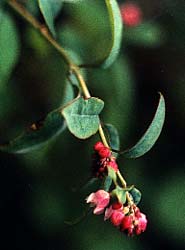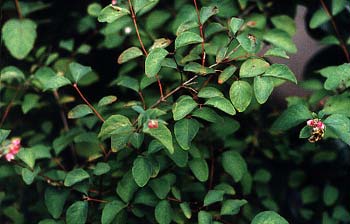
Snowberry, aka Waxberry or Snake Berry
aka White Coralberry
"Since I lost you, my darling, the sky has come near,
And I am of it, the small sharp stars are quite near,
The white moon going among them
like a white bird among snowberries,
And the sound of her gently
rustling in heaven like a bird I hear."
-D.H. Lawrence
(1885-1930)
(1885-1930)
Granny Artemis & I were at a little park on a nearby lake when I saw the most beautiful wild bushes that had planted themselves by nature's design about one each underneath every large Douglas fir tree. They had tiny pink flowers & dense bluish green foliage.
 I asked Granny Artemis, "Do you know what that wonderful bush is?"
I asked Granny Artemis, "Do you know what that wonderful bush is?""I think it's Snowberry," said she.
"It's so beautiful. I don't remember seeing Snowberry for sale anywhere."
"Sure, Country Nursery has a couple nice ones in their native plant section."
"Really? They must not look like much compared to these wild ones, or I'd've remembered."
"Oh, I dunno, the nursery's snowberries are pretty nice. Maybe we should go look & see."
Later that afternoon, we bought one. It was about three & a half feet tall, two feet wide, with excellent dense limb structure. Younger specimens can look awfully twiggy, but mature specimens can develop a trunk & woodier limbs, with lots of twigs built around the substantial heart. All the ones we saw in the wild were four feet tall & wide, but they do sometimes reach six or seven feet. Ours has rapid growth & needs periodic pruning or it will impose too much on the path.
 It's not just a Native Northwest shrub, as it's actually found wild throughout North America. It has gotten rare in many regions in the east due to habitat loss & predation by plant-hunters. Here in the Northwest it is very common in the understory of shady woods. It likes it best under Douglas Firs at the very edge of forests, where it does get some direct light part of each day. The nursery tag said it liked lots of sun, but none of the ones in the wildlife refuge were in full sun, so we gave ours the same dappled-shade environment they were selecting on their own, & it has done beautifully for us.
It's not just a Native Northwest shrub, as it's actually found wild throughout North America. It has gotten rare in many regions in the east due to habitat loss & predation by plant-hunters. Here in the Northwest it is very common in the understory of shady woods. It likes it best under Douglas Firs at the very edge of forests, where it does get some direct light part of each day. The nursery tag said it liked lots of sun, but none of the ones in the wildlife refuge were in full sun, so we gave ours the same dappled-shade environment they were selecting on their own, & it has done beautifully for us.Ours is the Northwest variant Symphoricarpos albus var. laevigatus, the Pacific Slope Snowberry. The Eastern Slope Snowberry clear across the continent from us is S. albus var. albus. I've never seen them side by side so I don't know how obvious a difference there is, but judging from pictures, the Eastern Slope Snowberry gets rangier, while the Pacific has denser foliage.
When Meriweather Lewis collected the Pacific Slope Snowberry during the Lewis & Clark Expedition, & brought living specimens to Thomas Jefferson, Jefferson seemed deliriously happy. He cultivated it successfully, & in 1813 wrote about it to Madame la Cometesse de Tesse, sending her cuttings. Soon European cultivators were making it available to continental gardeners, plus it was grown England from 1817. The berries contain two hard seeds each, so when birds ate snowberries then pooped in the forest, Snowberry was assured of becoming naturalized in France, England & many parts of Europe.
Snowberry is relatively slow-growing in terms of height, but can broaden quickly if unrestrained. It periodically needs its suckers pruned to not go too wild & to retain a bushy appearance. It is otherwise naturally very compact & rounded in habit, not requiring pruning to shape, only to size. A row of snowberry bushes can be effectively sheered into a hedge, although that wouldn't be my own preference for it.
Bright green leaves begin round & age into three-lobed almost maple-like leaves. This feature is as interesting as the snow white berries: it has both the round & lobed leaves on its branches spring through autumn. The pink & white bell-shaped flowers are quite small, in full bud in May & at their height in late June & July, with some flowers as late as September.
The fruit is ripening August through October. When it sheds its leaves by November, the snow white berries remain on the limbs much of the rest of the winter, rendering the shrub a highly decorative addition for the winter garden.
The berries are a half-inch round & have a little "nipple" at the tip, extremely attractive, variously three to eight in a cluster, more or less. It is an acceptable food resource for many wild animals, the leaves as well as the berries being browsed by bighorn sheep, deer, elk, & other animals. The berries are eaten by fox squirrels, cottontails, pocket gophers, & by many large birds. In the garden, however, they're not such a favorite of birds that they vanish too soon.
The berries are terribly bitter & are not widely regarded as edible for humans; indeed, many are the claims that it is toxic. If eaten in quantity it can cause vomiting & diarrhea, but if only a few would eaten, according to folk-medicine practices of the Stl'atl'imx of British Columbia, snowberry settled rather than disturbed the stomach.
The alleged toxicity of snowberry would seem to be exaggerated, however, or else the toxins break down in preparation, for it was a traditional food resource for some Northwest First Peoples who ate them dried or preserved in bear grease, though it was never a first choice berry harvest.
Though coastal peoples knew them to be edible in a pinch, some inland native peoples felt a superstitious dread of their ghostly whiteness, which may explain the traditional belief of their great toxicity. They were called Corpse Berries & were believed to provide sustenance for the wandering dead.
An October 2003 photo shows a branch of snowberries dangling above a patch of red-berried wintergreen which looks much smaller for being further along the path. Additional portraits are on the Snowberry Page of the Berries Gallery.
Snowberry had several uses beyond being occasionally eaten. In Northwest longhouses, fires were built in the middle of the floor, without chimneys, & the smoke did not invariably go straight up to the smoke-hole. Therefore the Northwest's longhouse dwellers frequently had irritated lungs & eyes from the smoke. Snowberry leaves & fruit were mashed into a paste used as a soothing poltice for injured or runny eyes. The bark was used for a medicinal tea, in particular for lung infection & to ease the effects of tuberculousis. The waxy white berries additionally made a good soapy "Indian shampoo."